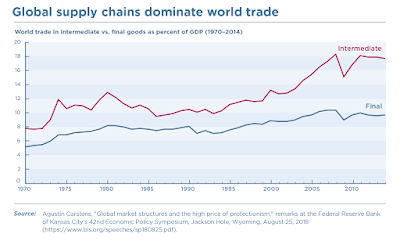PIIE have an excellent feature on globalisation.
1. Global trade has skyrocketed since about the 1950s, and especially since the nineties.
2. This has coincided with steep declines in tariffs across major economies.
3. Four-fifths of world trade is driven by supply chains of multinationals. Trade in intermediate goods is double that of final goods.
4. US had an overall trade deficit of $447 bn in 2017, with a very large deficit in goods offset partially by a smaller surplus in services.
5. Since the war, the share of jobs in US manufacturing has declined steadily, with that of services rising from just over half to 84% from the fifties to 2018. But strikingly, even as the absolute number of employees in manufacturing have declined, the value of output has increased significantly.
6. The balance sheet of post-war global trade expansion on the US economy is unambiguous.
1. Global trade has skyrocketed since about the 1950s, and especially since the nineties.
2. This has coincided with steep declines in tariffs across major economies.
3. Four-fifths of world trade is driven by supply chains of multinationals. Trade in intermediate goods is double that of final goods.
4. US had an overall trade deficit of $447 bn in 2017, with a very large deficit in goods offset partially by a smaller surplus in services.
5. Since the war, the share of jobs in US manufacturing has declined steadily, with that of services rising from just over half to 84% from the fifties to 2018. But strikingly, even as the absolute number of employees in manufacturing have declined, the value of output has increased significantly.
6. The balance sheet of post-war global trade expansion on the US economy is unambiguous.
7. But the aggregate hides concentrated particulars. This about the very localised displacement effects of globalisation on population clusters is central to the backlash against it,
Certain manufacturing and industry workers in specific geographic regions lost out, such as those in furniture, apparel, steel, auto parts, and electrical equipment industries in Tennessee, Michigan, and the mid-Atlantic states... The problem is compounded because policymakers have done little to help workers and communities adjust at a time when the wealthiest Americans have gained the most in recent years.
The answer to this problem is well known,
Instead of sacrificing trade gains, many economists recommend domestic policies like wage insurance, expanded tax credits, better unemployment benefits, and subsidies for health insurance for all displaced workers regardless of the cause. Such policies could reduce worker anxiety about job turnover across the board, whether it be from trade or other bigger factors. Currently, there is government support through a program called Trade Adjustment Assistance (TAA), though it only helps workers directly impacted by trade and the amounts paid are limited... Broader domestic policies can also help workers adapt to the continuously changing job market, such as access to higher education and health care, but Americans remain conflicted about the government’s role in these social safety net programs. Other advanced economies have generally increased the size of government programs as they opened up to trade.
But the challenge is with walking the talk with actual policy actions,
The United States spends only a fifth of what other advanced economies spend on average to help people find new jobs through education, training, job search assistance, and other active labor market programs.
The relevance of economy-wide social safety nets to cushion those impacted and vulnerable to various trends assumes even greater importance in light of technology and globalisation induced practices like automation and production unbundling and offshoring. No country, including developing ones, is immune to these forces.






No comments:
Post a Comment